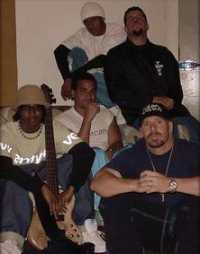Suicidal Tendencies have never been a band to compromise nor capitulate to the demands of style, whether in music or dress. Based in Venice, California, they were forever being condemned for not fitting into popular punk scene of the time because they had lead breaks in their songs, and never fitting into the metal scene because they were too fast.
Singer Mike Muir put the outfit together in 1982 along with school friends Louiche Mayora on bass and guitarist Grant Estes - later to be replaced by Rocky George - for fun. Drummer Ralph Herrera was later to join the ranks. They dressed in the style of which they lived; plaid shirts embellished with unique hand painted designs and bandanas.
Their debut album "Suicidal Tendencies" saw the light of day on the independent frontier records in 1983. They then set out to tour around America to spread the word with no as much as a promotional budget behind them, which explains why they came back from it a whole lot thinner than when they set off.
The most they were paid for a show was about $100 and they invariably ended up playing a lot of gigs for free: on some occasions this wasnt the plan intended, it just happend. Subsequent to their arrival back home they found that the local attitudes had changed towards them: they were getting air play on the radio with their first single "Institutionalised". MTV soon picked up the trail, giving the video heavy rotation from which it gained a 15 week run and made the top 28 videos of that year. "Institutionalised" also featured in the movie "Repro Man" as well as a series of Miami Vice, in which the band made an appearence performing the track.
This first album grew in popularity over the ensuing months and within the first 3 years of its release, had sold around 150.000 copies.
Prior to this ascendancy, no major record companies wanted to know a band with such a socially unacceptable name, but tables always turn, and turn they did because soon the wolves came sniffing; only they had changes in mind so one by one they were turned down, until the Virgin owned Caroline label offered a deal that gave ST total artistic control over everything. They took it.
Hounded by the moral majority because of their name, vocalist Mike Muir has always insisted that they don't condone suicide; in fact the name came about because of the crazy things that he used to get up to when he was younger. And whereas most rock bands pose around on Harleys, these guys took to skateboards for which the name ST has become synonymous.
"Join the army", their second album and first for the Caroline label ended up being three years in the making due to various catastrophes that accured whitin the ranks of the band. It finally emerged in 1987 to much critical acclaim. The first single "Possessed to skate", was accompanied by another self-made video about a kid who, along with his friends, thrashes his parents house whilst they are away, turning it into a skateboard heaven along with the swimming pool. The house used in the video actually belonged to a friends parents. The deal was that they fixed it up afterwards.
Major label exposure came a year later (1988) with the first album for Virgin records in Britain and Epic records in America, this being "How Will I Laugh Tomorrow When I Cant Even Smile Today". By this stage in the game, the musical approach of the band had improved considerably although some personnel changes had taken place, in that they had augmented their ranks with the addition of rhythm guitarist Mike Clark and Louiche Mayora had been replaced by bassist Bob Heathcote. The album was produced by Mark Dodson (known for his work with anthrax) who was credited by many people for enhancing ST's overall sound. Outstanding numbers such as the first single "Trip At The Brain" as well as the call to the faithful in "Pledge Your Allegiance" and "Surf and Slam" brought them incredible reviews and helped swell their already burgeoning ranks of followers.
Suicidal Tendencies are a pure inexorable energy with a steel edge.
Peter Grant (Riff Raff Magazine)
